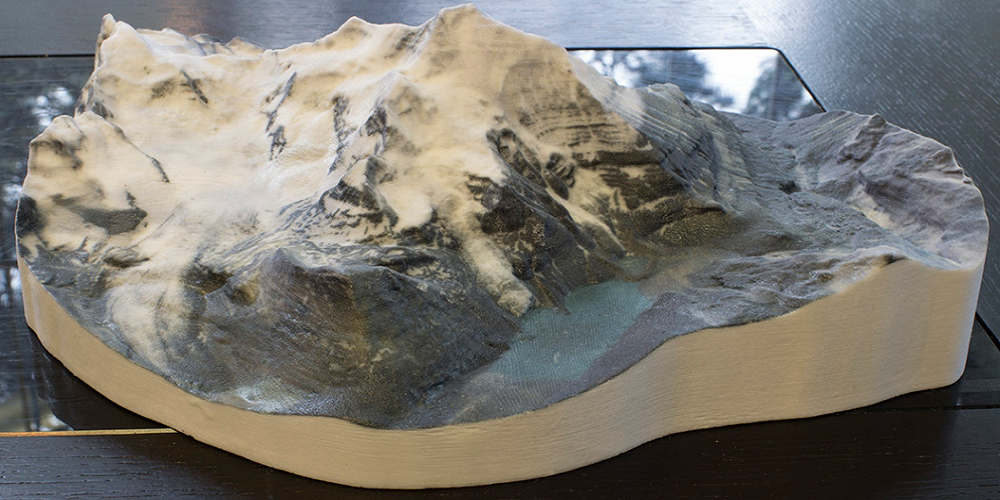
Many of us also find life to be a journey of climbing mountains, and as soon as we’ve conquered one–it’s on to the next. For Corbel 3D these days the team is busy conquering mountains, real ones, but in their own way: via 3D.
“We recently worked with the Discovery Channel to 3D Scan the largest peak in the Canadian Rockies from a Helicopter and then printed it on our Projet660,” Corbel 3D’s Patrick Wirt told 3DPrint.com, adding that tonight “the story goes live on the Discovery Channel!”
The team 3D scanned this mountain just like they would any body, but adjusting for a mass that is standing 3,954 meters tall (almost 13,000 feet) in a mountainous tundra, surrounded by unpredictable weather conditions. The team just upped their game to the new proportions, strategizing over weather conditions, braving a delicate helicopter maneuver.
“Within minutes of takeoff, temperatures dropped from 25° Celsius to less than 0° providing frigid cabin temperatures in doors-off helicopter that offered no shelter from the high speed wind chill. We persevered through the cold, while trying to ignore the fears of possible frostbite we had on our camera trigger finger,” said the team on their blog.
“Proper planning was absolutely essential as we had only one and a half hours of flight time, and 10 square kilometers to scan using only a single DSLR camera and GPS receiver,” said the team. “We adopted the same general rules as we would for body scanning and planned an eight-loop route around the mountain at various altitudes. The goal was to get enough overlapping coverage from as many different angles as possible so that wouldn’t miss any important features.”
Once having overcome that challenge, the team still had to deal with the fact that weather conditions had caused issue due to dark clouds–which meant they had to break the mountainous images into chunks for the scanning and processing, which took a week to complete.
“Once the chunks had finally finished processing, we made final tweaks to remove noise in Zbrush and Mari, and printed it in full color with our 3D Systems ProJet 660,” stated the team on their blog.
This type of work is known as environment scanning, and indeed is often used to make stunning visual effects. You can see how companies like Corbel 3D would be asked to make such digital works for the film industry and more, and with this example, the team is able to prove how massive these digital projects and 3D prints can actually be.
Nearly a thousand images, all coming from various angles, were used in creating the files for the Mt. Robson 3D print. The team used Agisoft Photoscan to piece together all the ‘chunks’ of the mountain, which were then finally ready to be printed–in full color–using a ProJet 660 by 3D Systems.
“We are part visual effects company through www.PixelLightEffects.com and part engineering, through Corbel 3D,” Wirt told 3DPrint.com, ” so we thought this would be an interesting mix of our specialties in both 3D scanning and printing!”
After the amount of monumental effort that went into this piece on both land and air, we’re all pleased to be able to see the fruits of their efforts from the 3D printer. With this type of work, on such a scale, the 3D print is able to display much more than we often see anywhere in terms of true environmental features like cracks, stains, and erosion. As the team points out, they were able to use the technology of 3D printing to recreate ‘billions of years of evolution.’ It’s quite appropriate as the team is involved in playing an incredible part of their own in technological evolution and history in the making. Catch more on this story tonight, October 7, at 7 p.m. EST on Discovery Channel.
Let us know your thoughts on this print in the Mt. Robson Forum thread on 3DPB.com.
